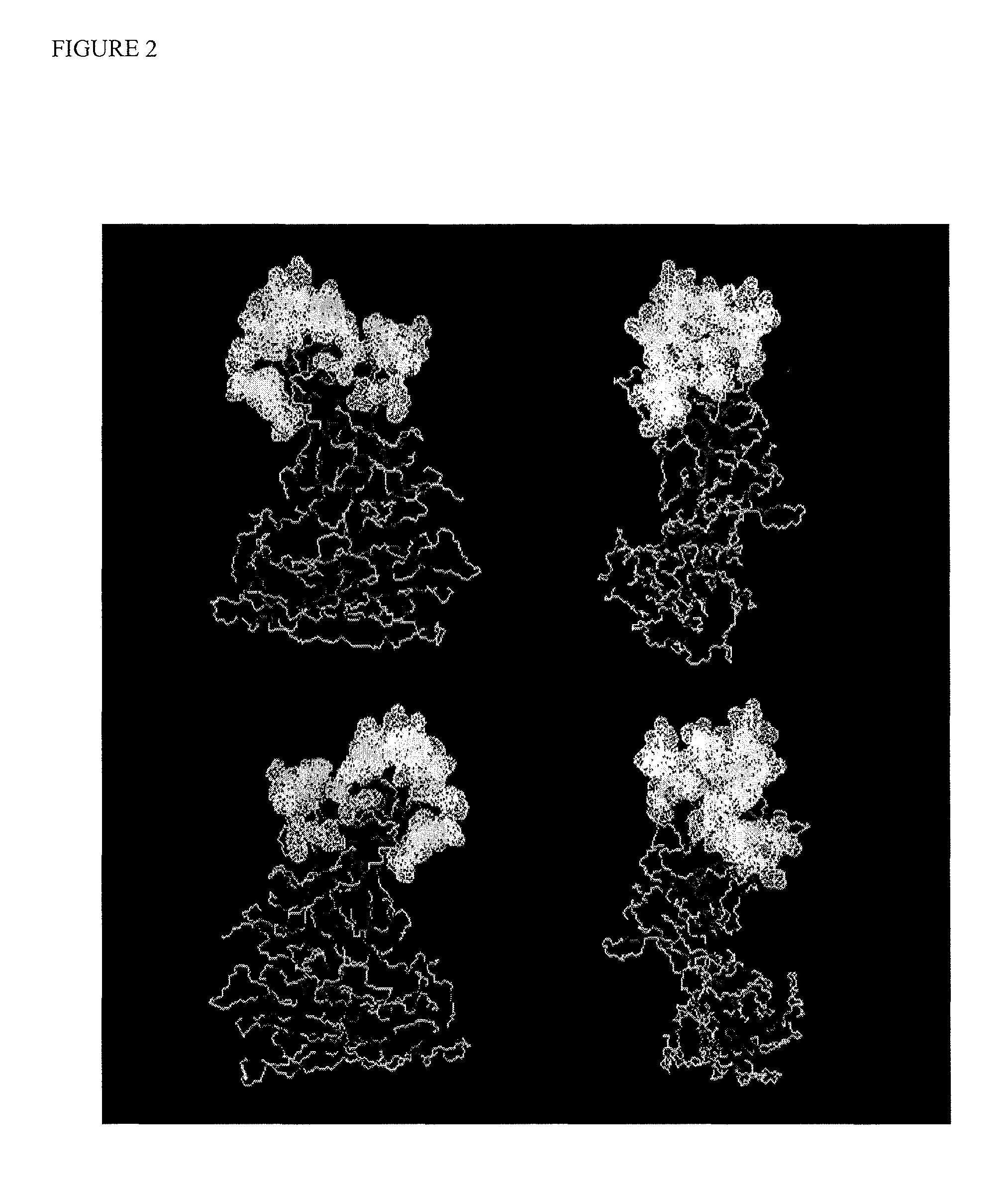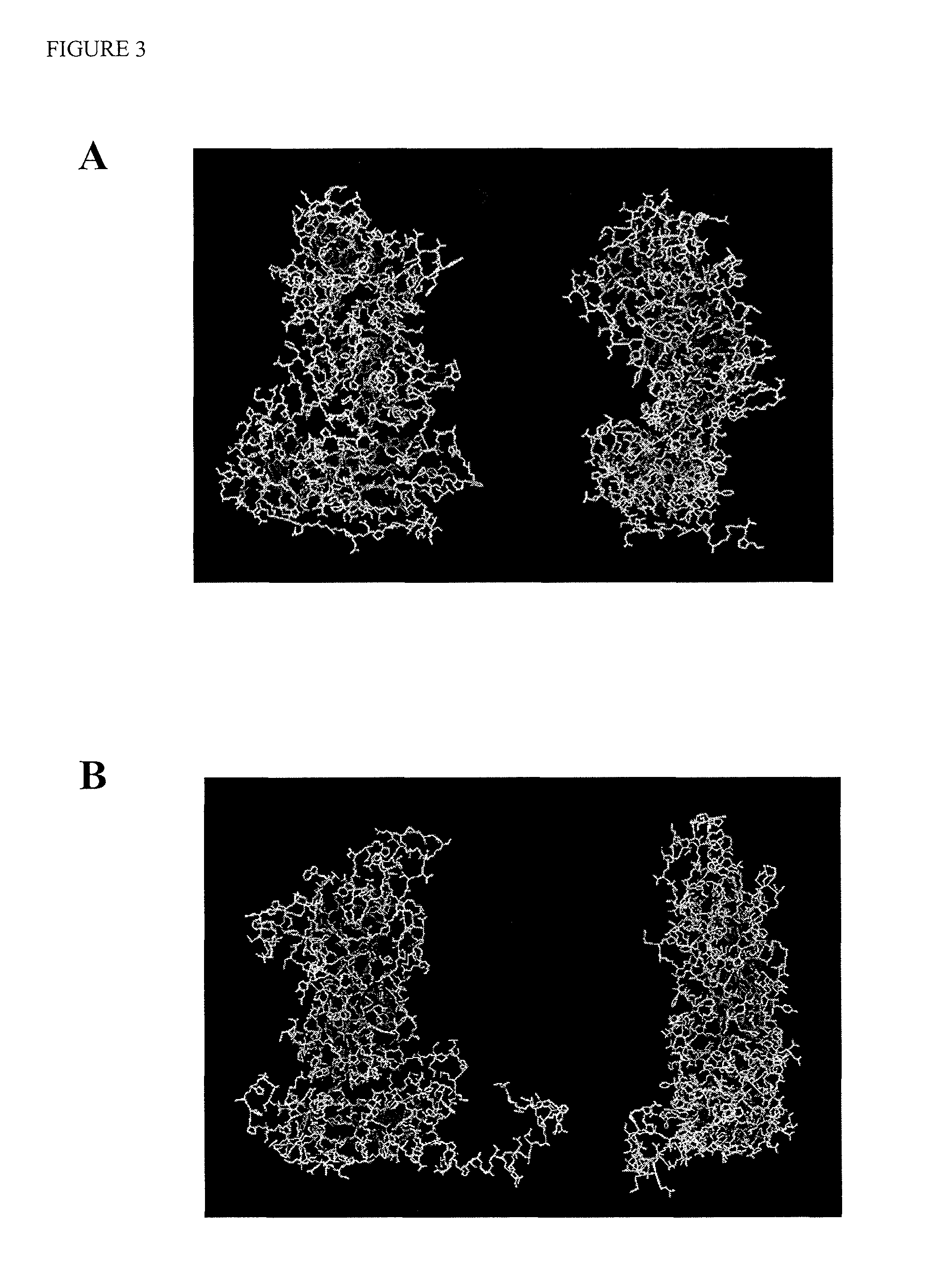Targeted heterologous antigen presentation on calicivirus virus-like particles
a technology of calicivirus and antigen presentation, which is applied in the field of calicivirus capsid proteins, can solve the problems of reducing the production efficiency of vlps, reducing the risk of infection, and producing weak immune responses, and proving difficult to achieve the effect of vlps production for some viruses
- Summary
- Abstract
- Description
- Claims
- Application Information
AI Technical Summary
Problems solved by technology
Method used
Image
Examples
example 1
Identification of Antigen Insertion Sites in Calicivirus VLPs
[0084]The bioreactor production and downstream processing of Norovirus virus-like particles (VLPs) is well-characterized and has been used for initial proof-of-concept studies demonstrating generation of chimeric Calicivirus VLPs. For the GI.1 Norwalk VP1 subunit, identification of surface-exposed loop regions suitable for insertion of foreign epitopes (see FIG. 1A) was carried out by evaluation of the high-resolution x-ray crystal structure (PDB code 1IHM). Similar evaluation of a composite GII.4 Norovirus capsid protein (GII.4 consensus) was conducted (see FIG. 1B) following generation of an atomic structure model using the program Geno3D2. This software uses the atomic structure of homologous proteins as a template (GI.1 Norwalk in the case of GII.2 consensus), and provides a strategy that will similarly be used to generate a structure model for any Calicivirus capsid protein of sufficient sequence similarity and lackin...
example 2
Insertion of Foreign Epitopes in Calicivirus VP1 Open Reading Frames
[0089]Two distinct strategies were employed for a comprehensive screening of foreign epitope insertion into preferred sites of the GI.1 Norwalk VP1 subunit: 1) simple insertions at various residue positions in solvent-accessible loops of the P2 domain; and 2) replacement of solvent-accessible loop residues of the P2 domain.
[0090]Mutagenesis involving inserts of 9 amino acids was conducted using appropriate synthetic oligonucleotides as mutagenic primers, while constructs with larger inserts were generated by gene synthesis. An alternative strategy for generation of chimeric VLPs with larger inserts involves engineering unique restriction sites into desired regions of the VP1 reading frame in order to ligate either synthetic DNA or PCR products encoding the appropriate epitope sequences. Similar strategies are carried out for epitope insertion in additional Calicivirus capsid proteins.
[0091]For first generation const...
example 3
Production of Chimeric Calicivirus VLPs
[0092]Generation of recombinant baculovirus encoding chimeric Norwalk VP1 subunits was conducted by co-transfection of transfer vector (pVL1393-Norwalk VP1) and linear baculovirus DNA into adherent Sf9 insect cells, followed by further virus expansion to generate high-titer stocks. As an initial proof-of-concept screen for production of chimeric VLPs, a model epitope derived from the influenza hemagglutinin antigen (HA epitope sequence-YPYDVPDYA (SEQ ID NO: 5)) was directly inserted after Norwalk VP1 residue 296, 336, 362, 383 or 399. In addition, expression trials were conducted for constructs where this model antigen replaced Norwalk VP1 residues 337-341 or residues 362-366. FIG. 7 shows Norwalk VP1 residues that either contain a direct insertion or have been replaced by the model hemagglutinin epitope.
[0093]For production of chimeric VLPs, Sf9 insect cells were grown to 2×106 cells / ml in 50 mL spinner-flask cultures and then infected with P1...
PUM
| Property | Measurement | Unit |
|---|---|---|
| OD | aaaaa | aaaaa |
| OD | aaaaa | aaaaa |
| molecular weight | aaaaa | aaaaa |
Abstract
Description
Claims
Application Information
 Login to View More
Login to View More - R&D
- Intellectual Property
- Life Sciences
- Materials
- Tech Scout
- Unparalleled Data Quality
- Higher Quality Content
- 60% Fewer Hallucinations
Browse by: Latest US Patents, China's latest patents, Technical Efficacy Thesaurus, Application Domain, Technology Topic, Popular Technical Reports.
© 2025 PatSnap. All rights reserved.Legal|Privacy policy|Modern Slavery Act Transparency Statement|Sitemap|About US| Contact US: help@patsnap.com



